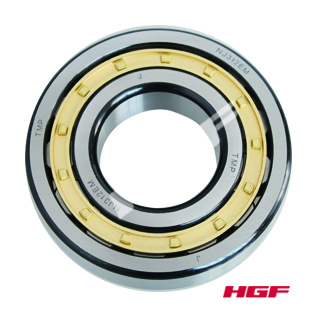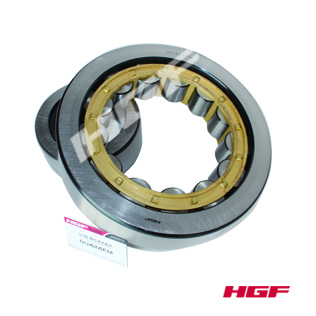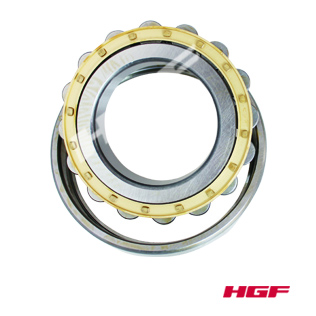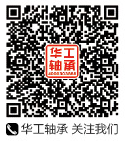Bearing failure? Detection, processing, simple and practical, very convenient!
Publisher£ºadminPosttime£º2016-01-01 21:24:05Views£º768Label£º
Bearing failure? Detection, processing, simple and practical, very convenient!
1
Abnormal rotation analysis diagnosis
Abnormal rotation sound detection analysis is auscultation method is used to analysis of the bearing condition monitoring method, commonly used tools are long wooden handle screw whorls, can also use hard plastic tube diameter is about 20 mm. Relatively, the use of electronic stethoscope monitoring, more conducive to improve the reliability of monitoring. When the normal work of the bearing, stable running, light, no stagnation phenomenon, the sound of harmony and no noise, can be heard even and continuous "sound" sound, or lower "rumbling" sound. Bearing abnormal sound is a reflection of the fault as follows.
1) bearing a homogeneous and continuous "hissing" sound, the sound is produced by the outer ring, roller rotation and that contains a metal has nothing to do with the speed of irregular vibration noise. General performance for the bearing inner fatliquoring quantity is not enough, should be added. If the equipment downtime is too long, especially during the winter low temperature circumstances, bearing during operation sometimes rustling "hissing sound, with the bearing radial clearance to smaller and smaller work grease penetration. Should be appropriately adjust bearing clearance, replacement penetration bigger new grease.
2) bearing in successive "sound" sound issued a uniform periodic "wow" sound, the sound is due to the rolling element and the inner and outer ring raceway there scars, grooves, rust spot. Sound cycle is proportional to the speed of the bearing. Bearing for replacement.
3) bearing of irregular and uneven "scrape" sound, the sound is due to the bearing inner into the iron filings, sand and other impurities. Sound intensity is small, is not connected with the revolution. Cleaning should be made for bearing with fat or oil change again.
4) bearing a continuous and irregular "rustling" sound, the sound general and bearing inner ring and shaft fits too loose or outer ring and bearing hole fits too loose. Sound intensity is larger, bearing inspection cooperation relations, found that the problem timely repair.
2
Vibration signal analysis diagnosis
Bearing vibration is sensitive to bearing damage, such as peeling, indentation, rust, crack and wear will be reflected in the bearing and the vibration measuring. So, through the use of special bearing vibration tester (frequency analyzer, etc.) can measure the size of the vibration, through frequency distribution can infer the abnormal situation. Measured values of bearing or sensor installation position and different using conditions, thus requiring prior to each machine is analyzed by the measured value of the determined after judgment standard.
Rolling bearing fault detection diagnosis technology has a lot of kinds, such as vibration signal detection, lubrication oil analysis detection, temperature detection, acoustic emission testing, etc. Among various kinds of diagnostic methods, based on the vibration signal of diagnosis technology most widely used, the technology can be divided into simple diagnosis method and precise diagnosis method two kinds. Simple diagnosis using the various parameters of the vibration signal waveform, form factor, crest factor, such as amplitude probability density, kurtosis coefficient, etc., as well as a variety of demodulation technology for bearing a preliminary judgment to confirm whether a failure; Precise diagnosis with various kinds of modern signal processing method to judge the simple diagnosis is considered a failure of bearing failure type and reason.
3
The simplicity of rolling bearing fault diagnosis
In the process of using simple diagnosis to rolling bearing vibration, the vibration is usually measured value (peak and RMS values, etc.) and given some standard comparison, determine in advance according to the measured vibration value is beyond the limits of the standards to judge whether the bearing failed, to decide whether to need further precision diagnosis. Used for rolling bearing the simple diagnosis criterion can be roughly divided into three types:
: (1) the absolute determination standard is used to determine whether the measured vibration value transfinite absolute value; (2) the relative decision criteria: it is of the same parts of the bearing vibration test on a regular basis, and in comparison, with the vibration value of bearing under the condition of trouble-free standards, according to the measured value of vibration and the vibration value of the diagnosis to the ratios and standards; (3) analogy decision criteria: it is the number of the same type of bearing under the condition of the same vibration tests in the same place, and to compare the vibration value judgment standard.
Absolute standard is the prescribed test methods on the basis of the standards, so must pay attention to the suitable frequency range, and must be in accordance with the provisions of methods for vibration detection. Applies to all bearing there is no absolute standard, thus are generally combination absolute standards, relative standards and analogy decision criteria, so as to obtain accurate and reliable diagnosis results.
4
The precision of rolling bearings' faults diagnosis method
Rolling bearing vibration frequency composition is very rich, which has low frequency components, and high frequency components, and each specific failure due to specific frequency components. Precision diagnosis task, is must through the appropriate signal processing methods to isolate specific frequency components, thus indicating the existence of the specific fault.
There are several kinds of commonly used precision diagnosis.
(1) the low frequency signal analysis
Low frequency signal refers to the vibration frequency less than 8 KHZ. Generally use the acceleration sensor measurement of rolling bearing vibration, but the low frequency vibration velocity signals analysis. Acceleration signal, therefore, should pass by the integrator signal conversion rate after the charge amplifier, and then through the upper cut-off frequency of 8 KHZ low-pass filter to remove the high frequency signal, finally carries on the frequency component analysis, in order to find the characteristic frequency, signal diagnosis.
(2), high frequency signal demodulation analysis method
Intermediate frequency signal of the frequency range of 8 KHZ - 20 KHZ, high frequency signal frequency in the range of 20 KHZ to 80 KHZ. For medium and high frequency signal can be directly analyzed acceleration sensor signal after charge amplifier, directly through the high-pass filter to remove the low frequency signal, then carries on the demodulation, the frequency analysis, to find out the characteristics of the signal frequency.
5
The temperature of the bearing analysis diagnosis
Bearing temperature, generally have a bearing on the surface of the outdoor temperature can be predicted, if using the oil hole can directly measure temperature of bearing outer ring, is more appropriate.
In general, the temperature of the bearings with bearing operation began to slowly rise, 1 to 2 hours to reach a steady state. The normal temperature of bearing for machine and different heat capacity, heat dissipating capacity, rotational speed and load. If the lubrication, installation is not appropriate, the bearing temperature will rise sharply, appear unusually high temperature, then must stop running and take necessary precautions.
With high temperature often said bearing is in abnormal situation. High temperature is harmful to the bearing lubricant. Sometimes overheated bearings can be classified to the bearing lubricant. If the bearing temperature for a long time even the transfer of more than 125 ¡æ lower bearing life. The causes of high temperature bearing include: insufficient lubrication or excessive lubrication, lubricants contains impurities, heavy load, bearing damage, inadequate clearance and high friction produced by the oil seal and so on.
Therefore, continuity of bearing temperature monitoring is necessary, whether it is measuring the bearing itself or other important parts. If it is on the basis of the operating conditions, the temperature change of any fault has occurred.
Bearing temperature measurement can help make a thermometer on a regular basis, SKF type digital thermometer, for example, can be accurately measured bearing temperature and the constant unit in accordance with ¡æ or Fahrenheit display.
The importance of bearing, means that when the damage, can cause equipment downtime, so this type of bearings shall be equipped with best temperature probe.
In just under normal circumstances, bearing lubrication or lubrication after there will be a natural temperature rise and continue a day or two days.
6
Lubricant analysis diagnosis
Lubricant analysis method is to use iron spectral analysis technology, iron spectrum analysis technique is particularly suited to a method of identification and prediction rolling fatigue. Will be part of rolling bearing lubricating oil extraction as a sample, the use of high gradient magnetic field so that flow through the field sample contains solid foreign body, according to the size scale deposition on the glass, to observe the shape of a foreign body particles, size, color and material, which can clearly determine the wear types, forecast of the machine running condition, found hidden danger in time. Iron spectrum technique in principle to identify the strong magnets, such as steel as the main target, but for non-ferrous metals such as copper, sand, organic matter and seal clastic foreign body also has a fairly good identification ability.
When the sample in 1-5 microns diameter steel kind of spherical particles, the bearing micro cracks started to appear fatigue. When sample length and thickness ratio of 10:1 in the fatigue spalling of particles, and the length is more than 10 microns, bearing the china-africa normal fatigue wear has started, when the length is more than 100 microns, the bearings have failed.
Third fatigue debris for the length and thickness ratio of spake fatigue flake, its length is between 20 to 50 microns, chips are often with a hole. When began to appear in the fatigue, the number of the wafer will increase obviously, this can be as a sign of fatigue appeared together with the spherical particles.
7
Acoustic emission testing
Principle of acoustic emission testing technology, material by external or internal force deformation or crack propagation, the release of strain energy in the form of elastic wave phenomenon called acoustic emission. Use instrument testing and analysis of acoustic emission signals and inference by using acoustic emission signals of acoustic emission source technology, called acoustic emission testing technology, the use of material particles due to the relative motion and strain energy released in the form of elastic wave phenomenon to identify and understand the material or structure of the internal state.
Acoustic emission signal including emergency type and continuous type two kinds. Sudden type acoustic emission signal is composed of different from background noise of pulse, and can be separated in time; Continuous acoustic emission signal of a single pulse indiscernibility. In fact, continuous acoustic emission signal is composed of a large number of small type emergency signal, it's just too dense and unable to distinguish between. Rolling bearing in the case of defective operation, and emergency type and continuous type of acoustic emission signals are likely to produce. Bearing each component (inner ring and outer ring, rolling element and cage) relative motion between the surfaces and rubbing the Hertz contact stress, and such as surface crack due to failure, overload, etc, wear, indentation, grooving, bite, usually caused by poor lubrication of rough surface, the surface of the contaminated particle lubrication hard edges and pitting corrosion caused by bearing of current fault, will produce sudden type of acoustic emission signals.
Continuous acoustic emission signal mainly comes from poor lubrication, such as the failure of lubricating oil film, grease pollutants into) lead to bearing surface of the wear fault, high temperature and overall bearing of frequent occurrence of partial failure, etc., these factors in a short period of time of a large number of acoustic emission emergency, resulting in a continuous acoustic emission signal. Rolling bearing in the process of operation, its failure (both surface damage, crack and wear failure) will cause the contact surface elastic shock produced by acoustic emission signal, the signal contains abundant rubbing information, so can use acoustic emission monitoring and diagnosis of rolling bearing fault.
8
Vibration signal detection
Simple diagnosis of rolling bearing fault detection of rolling bearing vibration signal analysis of the fault diagnosis methods can be divided into simple diagnosis method and precise diagnosis method two kinds. Simple diagnosis is for the purpose of a preliminary judgment is listed as diagnostic object of rolling bearing is failed; Is the purpose of precise diagnosis to determine in the simple diagnosis is considered a failure of bearing failure type and reason. Mainly introduces several methods for the diagnosis of simple below:
(1) amplitude value diagnosis method, the amplitude of the mentioned here refers to the peak XP, average X (for the average of the harmonic vibration for half a cycle, bearing impact vibration by the absolute value of mean value) and root mean square (RMS) Xrms. This is one of the simplest and the most commonly used diagnosis method, it is by the amplitude of the measured values compared with determining the values given in the standard to diagnose. Peak reflects some point to the maximum amplitude, so it is suitable for such as surface pitting damage with instantaneous impact fault diagnosis. Basic means for diagnosis of effect and peak, its advantage is stable values peak, but usually used in the situation of high speed (such as more than 300 r/min). Root mean square value is the time average, so it is suitable for the amplitude values like wear fault diagnosis of slowly changing over time.
(2) probability density diagnostics trouble-free rolling bearing amplitude probability density curve is typical of normal distribution curve; And once a failure, the probability density curve may appear skewed or dispersion phenomenon.
(3) the kurtosis coefficients diagnosis method. Amplitude satisfy normal distribution regularity of trouble-free bearing, the kurtosis value is about 3. With the emergence and development of the fault, the kurtosis values are of a similar change trend and crest factor. The advantage of this method is that has nothing to do with the speed, size and load bearing, mainly used in fault diagnosis of pitting corrosion.
(4) waveform factor diagnosis method of waveform factor is defined as the ratio of peak to average (XP/X). This value is also used in simple diagnosis of one of the effective indicators of rolling bearings.
(5) the crest factor diagnosis crest factor is defined as the ratio of the peak and RMS values (XP/Xrms). The value is used for rolling bearing the advantages of simple and easy diagnosis is that it is not affected by the influence of the bearing size, speed and load, also from the sensors, amplifiers, etc. The primary and secondary instrument sensitivity changes. The value is suitable for pitting fault diagnosis. Through to the XP/Xrms values change over time trend monitoring, can be effectively carried out on the rolling bearing fault early warning, and can reflect the trend of the development of the fault. When the rolling bearing trouble-free, XP/Xrms, for the stability of a smaller value; Once appeared bearing damage, can impact signal, vibration peak value are increased, the root mean square value but at the moment there is no obvious increase, so the XP/Xrms increase; Fault when expanding, the peak gradually after reaching limit value, RMS value began to increase, XP/Xrms reduced gradually, until the return to the trouble-free size.
Through the above key equipment bearing parts detection means for detecting the running state of tracking, can effectively diagnose the equipment bearing parts of the hidden trouble, early prevention, to ensure that equipment normal use.
- 2016.03.03Industry News£ºReducer bearing a..
- 2016.03.03Industry News£ºWithout knowing t..
- 2016.03.03Industry News£ºUltrasonic vibrat..
- 2016.02.17Industry News£ºHigh-speed railwa..
- 2016.01.30Industry News£ºLow vibration bea..












